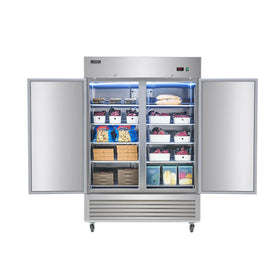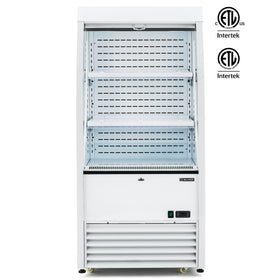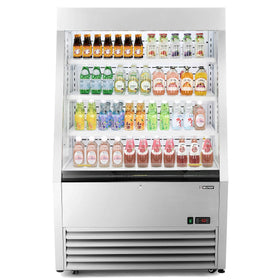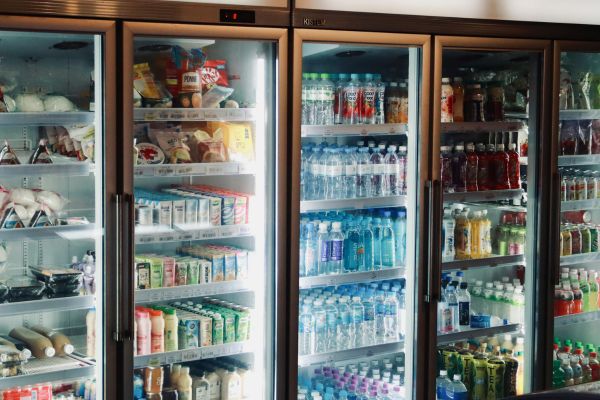Whenever you are shopping for a fridge, be it a regular household refrigerator or a commercial refrigerator, you are likely to come across two terms: counter-depth and standard-depth.
At first glance, you may think the difference between these two refrigerator designs is rather simple: one is shallower, the other deeper, but these designs serve different purposes, and knowing which one fits your needs can save you headaches, money, and space.
Understanding the differences between counter-depth and standard depth refrigerators is not only for homeowners and remodelers, but for anyone looking to balance style, storage, and function.

What is a Counter-Depth Refrigerator?
The term “counter-depth” means the refrigerator is designed to align closely with the depth of your kitchen countertops and cabinets (typically 24-25 inches). The counter-depth design gives the fridge a nearly flush, built-in appearance, ensuring that it blends seamlessly with the other equipment in your kitchen.
Key features of counter-depth refrigerators
Four important features characterize counter-depth fridges and ultimately distinguish them from standard fridges:
- Depth: They are usually about 24–30 inches (excluding doors and handles)
- Height: Typically 62–72 inches, but can sometimes be slightly taller to make up for reduced depth
- Capacity: They have less interior storage compared to standard models of the same width.
- Design: The design of counter-depth refrigerators is modern, streamlined, and aesthetically pleasing. They are designed for modern kitchens.

Where are Counter-Depth Fridges Used?
Counter-depth fridges are typically used in smaller (often) household Kitchens where kitchen space is limited, and style and flow are considered to be as important as storage capacity and refrigeration performance.
This explains why counter-depth fridges are becoming especially common in modern kitchens, especially those with a focus on aesthetics or minimalistic designs. Most modern Airbnbs, guesthouses, and high-end hotel lodgings have counter-depth fridges
However, they are also quite popular in open-concept or high-traffic kitchens where extra floor space matters.
What is a Standard-Depth Refrigerator?
A standard-depth refrigerator is designed to maximize storage capacity and prioritize performance. Hence, they tend to extend beyond the edge of countertops and cabinets.
This is the traditional style most people are familiar with and is built to maximize food storage capacity rather than fit flush with cabinetry.

Key features of standard-depth refrigerators
Standard-depth refrigerators are also distinguishable by some special features, such as:
- Depth: They are usually about 30-36 inches (excluding doors and handles)
- Height: Standard depth fridges typically 62-72 inches, similar to counter-depth, but sometimes slightly shorter
- Capacity: Standard-depth fridges have larger interior storage. They are ideal for bulky platters, gallons of milk, or big shopping trips
- Design: protrudes into the kitchen, making it more noticeable in the layout
What are Standard Depth Refrigerators Used For?
Standard-depth refrigerators are generally preferred where storage capacity is the main priority for getting a fridge. Think of larger households that need maximum storage.
- Kitchens where cabinet alignment is less important
- People who shop in bulk or need to store oversized items.
Major Differences Between Counter-Depth and Standard-Depth Refrigerators
The most obvious difference between a standard-depth fridge and a counter-depth fridge is that, unlike a counter-depth fridge, a standard-depth fridge does not try to blend itself into the overall design and/or aesthetic of the kitchen: it is prized for its larger interior storage capacity and is present to hold as many items as possible.
A counter-depht fridge, on the other hand, is prized for its sleek build and design as much as its storage capacity.
Here are some main differences between counter-depth and standard-depth refrigerators at a glance:
| Feature | Counter-Depth | Standard-Depth |
| Depth | 24-30 in (flush with counters) | 30-36 in (extends past counters) |
| Height | Often slightly taller, but both average 62-72 in | Similar range, sometimes a bit shorter |
| Capacity | Smaller interior storage | Larger interior storage |
| Design Purpose | Sleek, built-in look; saves floor space | Max storage, practicality, and lower cost per cubic foot |
| Best For | Style-focused kitchens, smaller spaces, open layouts | Families, bulk shoppers, and anyone needing maximum food storage |
Are Commercial Refrigerators Counter-Depth or Standard-Depth?
Commercial refrigerators are almost always standard-depth. They are built for maximum storage, durability, and easy access in high-use environments like restaurants, cafés, and cafeterias.
While aesthetics matter in home kitchens, in commercial spaces, the priority is clear: fitting as much food and drink as possible while ensuring safe and reliable cooling. This is why most commercial refrigerators are standard depth.
Also, commercial refrigerators are more versatile in use than a regular counter-depth refrigerator would allow. While most counter-depth fridges are used exclusively for cooling/storage of household items, different types of commercial refrigerators have different uses, many of which would not be accommodated by a regular counter-depth refrigerator.
- Commercial display refrigerators are used for storage as well as product display and marketing
- Commercial open-air merchandisers and display cases are also used for maximum accessibility.
- Prep table refrigerators, chef bases, and worktop refrigerators also double as cutting boards and preparation surfaces
Since these types of commercial refrigerators are more versatile in use, designed for practicality, rather than aesthetics. Hence, they are all more likely to be standard-depth refrigerators.

Final takeaway
Choose a counter-depth refrigerator if you want your kitchen to look sleek, modern, and space-efficient. Go with a standard-depth refrigerator if storage capacity and practicality are your top priorities. For commercial kitchens, standard-depth reigns supreme.
You might be interested in this guide on refrigerator sizes, both for commercial and home use.










